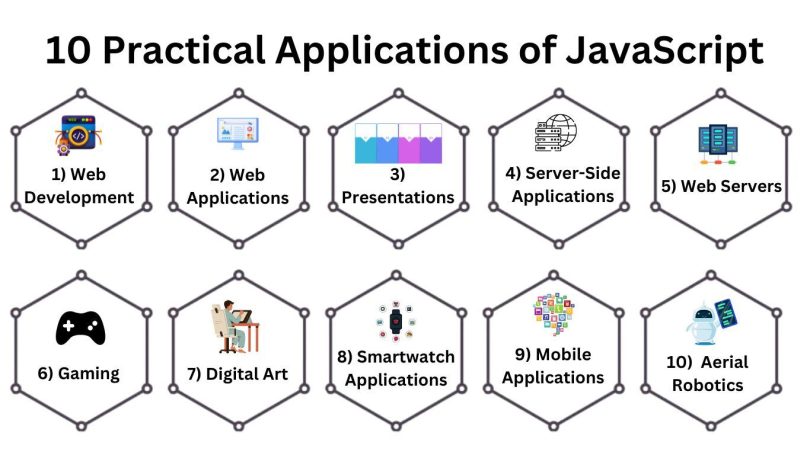In web development, JavaScript is a very powerful and common language that has the highest percentage of being used for 97.7% of all websites as a base client-side programming language. As a result, mastery of JavaScript is essential for the prospective web developers employed in this sector.
This article seeks to explore the practical use of JavaScript and provide insights into how to become a very competent JavaScript master.
Interactive Web Design with JavaScript:
Being a cross-platform and object-oriented programming language, JavaScript makes web pages very interactive by allowing the developers to develop dynamic content, animations, popup menus, clickable buttons and also multimedia controls. JavaScript works on both client-side and also server-side, complementing HTML and CSS in its provision of the interactive features that are very necessary for an effective user experience. Even without it, nearly 90% of the internet web pages would stay non-dynamic.
Why JavaScript? Compatibility and Simplicity
The popularity of JavaScript could be explained by the fact that it is very compatible with different devices such as iPhones, Androids, Mac OS, Windows and also Smart TVs. The widespread applicability stems from the capability of JavaScript to be employed in both front-end and back-end web development, catering to the needs of both seasoned developers and beginners alike. Among the reasons for its popularity, the adaptability of the language, no environment setup demand, standardization and regular updates are included.
Practical Applications of JavaScript:
It is enhanced by the fact that JavaScript works with the Document Object Model (DOM), which allows the users to react and turn web browsers into powerful application platforms. Having supportive of open standards and a very vibrant community, together with an array of frameworks and libraries only strengthens JavaScript’s position in the web development scene.
Now, let’s explore the practical applications of JavaScript across different segments:
1.Web Development:
JavaScript acts as a scripting language, which means it helps to create dynamic and interactive web pages that the users can easily engage with to execute complicated actions. Prominent sites such as Google, YouTube, Facebook and Amazon employ JavaScript to improve the user experiences.
2.Web Applications:
React Native, React, Angular, and Vue stand out as some of the JavaScript frameworks instrumental in crafting robust web applications. Platforms such as Netflix and PayPal have used AngularJS for the application development and integration with the APIs.
3.Presentations:
JavaScript is often applied in presentations like websites that are very interactive and it uses libraries such as RevealJs, and BespokeJs. Such frameworks allow the users to create web slide decks with many different functions, transitions and style features which improve the presentation process.
4.Server-Side Applications:
The utility of JavaScript is also extended to the field of server-side software development by means of node.js, an open source runtime environment. Developers use JavaScript in writing, testing and debugging the code to create applications that are very quick and also scalable for the network. It functions by generating and managing the HTTP requests. Companies such as Walmart, PayPal, Uber and also GoDaddy have adopted the use of Node.js in their server structure.
5.Web Servers:
In Node.js, developers can use the JavaScript for building web servers. The inherent event-driven characteristic of Node.js facilitates a seamless progression to subsequent calls, eliminating the need to wait for the completion of previous responses. This allows the fast delivery of the data packets without any buffering. The create Server method is used by the HTTP module for server creation.
6.Gaming:
JavaScript is a key element in web game development when used with HTML5. The EaselJS library has rich graphics for games, and the HTML5 technology does away with any other plugins such as Flash. The popular browser games such as the “Tower Building”, “CrossCode” and “HexGL” are based on JavaScript and also HTML5.
7.Digital Art:
With the help of JavaScript, the HTML5’s canvas element can create 2D and 3D graphics on web pages. This development has created a room for several digital art projects on the browsers. Those interested in digital art can utilize JavaScript to generate their own code and can produce art.
8.Smartwatch Applications:
The JavaScript framework by Pebble, named as Pebble.js, allows for the creation of apps for the Pebble watches in JavaScript.
Simple JavaScript code allows for developing a smartwatch app.
9.Mobile Applications:
JavaScript demonstrates its versatility by allowing the mobile devices to create non-web applications in the form of different contexts. Using frameworks such as “React Native” and “cross-platform” mobile app development can be achieved since it provides a single front-end for both the Android and also IOS platforms.
- Aerial Robotics:
JavaScript is commonly used in programming the drones. This capability is also about controlling many small robots that can help to create maker projects and IoT devices. With JavaScript, enthusiasts can enjoy the adventurous world of drones, the flying robots and quadcopters.
How to Pursue a Career as a JavaScript Developer?
JavaScript skills are the primary consideration for individuals moving into web development, as almost one-third of the programming job ads look for this skill. Today, there are about 13.9 million JavaScript Developers available in the world job market.
To be a JavaScript Developer it requires a lot of skill in “designing”, “testing” and implementing the software based on JavaScript.
For individuals aspiring to commence a career in JavaScript development, there are promising opportunities in various roles, including:
- Front-end Web Developer
- Web Application Developer
- Website Administrator
- Full Stack Developer
- Quality Assurance Automation Specialist
- Web Marketing Manager
Conclusion:
Beyond web pages, JavaScript’s magic reaches everything from interactive presentations to flying drones. With its multi-platform capabilities and constantly changing ecosystem, you can create dynamic web experiences; and build server-side applications or even mobile apps. From front-end development to QA automation, mastering JavaScript opens an endless path of opportunities. Therefore, immerse yourself in this multifaceted language, let your imagination run wild and influence the evolution of immersive computing.








Leave a Comment